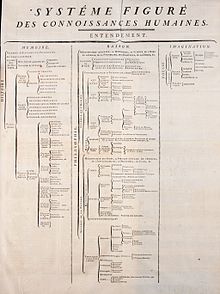
Back نظام تصويري للمعرفة البشرية Arabic Diderot’n ja d’Alembertin puu Finnish Système figuré des connaissances humaines French 具象人类知识系统 Chinese

The "figurative system of human knowledge" (French: Système figuré des connaissances humaines), sometimes known as the tree of Diderot and d'Alembert, was a tree developed to represent the structure of knowledge itself, produced for the Encyclopédie by Jean le Rond d'Alembert and Denis Diderot.
The tree was a taxonomy of human knowledge, inspired by Francis Bacon's The Advancement of Learning. The three main branches of knowledge in the tree are: "Memory"/History, "Reason"/Philosophy, and "Imagination"/Poetry.
Notable is the fact that theology is ordered under philosophy. The historian Robert Darnton has argued that this categorization of religion as being subject to human reason, and not a source of knowledge in and of itself (revelation), was a significant factor in the controversy surrounding the work.[1] "Knowledge of God" is only a few nodes away from divination and black magic.
The original version, in French, can be seen in the graphic on the right. An image of the diagram with English translations superimposed over the French text is available. Another example of English translation of the tree is available in literature (see the reference by Schwab). Below is a version of it rendered in English as a bulleted outline.
- ^ Robert Darnton, "Philosophers Trim the Tree of Knowledge: The Epistemological Strategy of the Encyclopedie," The Great Cat Massacre and Other Episodes in French Cultural History (New York: Basic Books, Inc., 1984), 191-213.